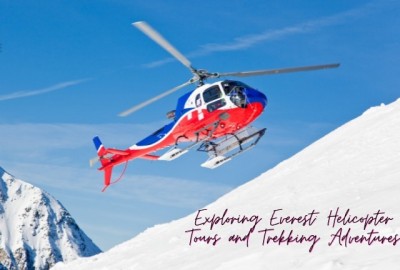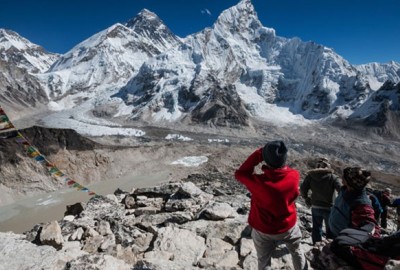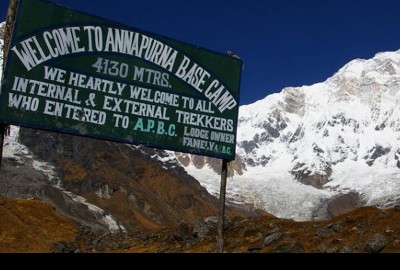Maybe for a few years, or maybe for decades, you have been dreaming about the famous Everest Base Camp Trek. This is where the trail follows in the footsteps of the dreamers, the lucky ones, and the dedicated ones, to the base of the highest mountain on earth, Mt. Everest (8848m). The spectacular Khumbu (Everest) region is nestled in one of the geographical wonders on this planet, the incredible Himalayas which create the northern border between Nepal and Tibet. Here is where many come to test their skill and fortitude to scale its summit. Here also is a trek that calls upon determination, strength, and a desire to ensconce oneself in the natural and cultural treasures of the Khumbu Region.
The trek is no short of wonders. Besides the fact that it leads to one of the most famous places on earth, the incredible natural splendor of the Himalayan Ranges opens up as the trail ascends into the heavenly alpine realm of the Sherpa people. Their culture and traditions are interwoven so tightly with Mt. Everest (8848m), that there is almost no separation between the two while thinking about trekking to the Everest Base Camp.
All of this and more await along this incredible trek, but what if you are a novice backpacker? Maybe you have done some hiking, exclusively day trips, but never overnight in the backcountry and definitely not at altitudes well over 4,000 meters. You may wonder if you are ready for such a journey in the lap of the Himalayas. It’s a good question to ask oneself because the trail has its challenges, but also many rewards. There are a few considerations when deciding if you are ready, and here, we give some helpful information for the fewer veteran backpackers and trekkers.
To decide if you are able to accomplish trekking to Everest Base Camp, it’s best to know what to expect.
Trip Grading and What to Expect in a Typical Day
The Everest Base Camp Trek is considered moderate. This means that you will be physically active for up to eight hours a day. Active is defined as a long day of trekking starting after an early breakfast, with a 1-2 hour break for lunch, then walking until evening when you reach a village where you will stay at a type of guesthouse. This trekking will be on rough terrain and uneven surfaces. The trail will also both ascend and descend significantly throughout the day, and can and will be steep in both directions. During this hiking, you will be exposed to the chilly weather of the growing altitude. Most go for this trek in the autumn and spring seasons which tend to have stable weather and fairly clear skies. However, cold rain, hot sun, a little snow, and high winds, or all of these conditions combined into one day can be expected and should be planned for. The elevation profile varies widely. From landing in Kathmandu at a mere 1,400 meters to flying into Lukla at 2,860 meters where the trek begins to Gorakshep, the highest settlement the trails reaches at an elevation of 5,164 meters, you will walk on trails the oscillate between these elevations. This is typically between 15 and 17 days depending on what variation in the itinerary you choose. Another important consideration is what you are expected to carry. The porters are provided to carry the heavier items freeing you to only keep what you would need during the day in your daypack. Things like extra layers for unexpected weather, water, snacks, sunscreen and lip balm, camera gear, and valuables area carried in your daypack.
So, in essence, a typical day is as follows:
- 6:30 am: Wake up and wash, dress, and pack your daypack
- 7:00 am: Breakfast
- 8:00 am: Begin hiking, with small 10 minute breaks scattered throughout the morning
- 12:00 pm: Lunch for one hour
- 1:00 pm: Continue hiking again with a few small breaks
- 4:30 pm: Arrive into a village and settle into a teahouse (small guesthouse)
- 5:00 pm: Enjoy tea, rest or explore
- 6-7 pm: Dinner
Now with the information about what to expect both in terms of physical activity and how the day looks in overall, you have information to take with you when you discuss with your doctor if you are ready for such activity. Once cleared for this level of physical activity, you then can choose if you are ready to take up the joys and challenges associated with trekking to Everest Base Camp.
Training for Everest Base Camp Trek
Let’s say you are physically fit, cleared for activity, and have the desire, but still are unsure because of your limited experience in this type of environment. You are the only person who can truly decide if you both want to and can trek this incredible trail. With that said many novice trekkers attempt and enjoy this unique journey every year. Training for this adventure will go a long way into enjoying the trek as well as to make you an active participant in your safety.
To prepare for a moderate trek, you should begin training at least four to five months before your departure. Generally, an hour of aerobic exercise three to four times per week would be considered a minimum requirement. Adding some resistance training at least two times a week is preferred. Think gradual progression with all aspects of training. Ideally, the best preparation is hiking involving relatively steep ascents and descents. If you can manage a couple of valley floor to ridgeline ascents per hike with your weighted pack, albeit with stops along the way, you will cope with a moderately graded trek. Speed is not important, stamina, confidence, and continuity are.
A Few Words on Altitude Sickness
Going above 2500 meters can cause alterations in our bodies due to the change in oxygen level. As our bodies adapt, we may experience certain symptoms. This is called Altitude Sickness, which can take up to and over a week of acclimatization to feel better. A proper itinerary for the trek can go a long way to helping minimize the symptoms of Acute Mountain Sickness or AMS, where the symptoms can include:
- Headache
- Tiredness
- Disturbed sleep
- Loss of appetite/nausea
- Shortness of breath
- Cough
- Palpitation
- Swelling of the hands and face
Each of us is different, and thus our bodies all react differently. It must be stated that physical fitness does not play a major role in how well your body handles going to higher altitude. What fitness does help with is being more familiar with what feels normal, and how to handle physical stress. Exercising means you know what it feels like to be out of breath and how to calm yourself when feeling this way. Your best strategy is to take your time and drink plenty of water. Also, simple carbohydrates are known to help with acclimatization because the body needs lots more energy to do all the things it needs to adapt to lower oxygen levels. So, it’s a good time to enjoy your favorite biscuits or cookies. These symptoms may not indicate the onset of AMS, and if you experience them, it does not necessarily mean that you should not continue. Group leaders should have extensive wilderness first aid training and it is vital you tell your guide or trip leader how you are feeling. AMS can progress to a more life-threatening condition, and your guide will know from your signs and symptoms if this is happening. Descent is the first line of defense if AMS is feeling overwhelming for you, or if it is progressing to something more serious.
Do I Need Any Special Gear for Everest Base Camp Trek?
All reputable companies will provide a detailed gear list, and what you need to take doesn’t go beyond the usual day hiking requirements for a typical Everest Base Camp Trek. In general, non-cotton clothes for trekking, a layering system that manages both cold and precipitation, a good 30-liter daypack, and trekking poles to help specifically with the descents. Again, check with your travel company about their suggestions for the trek.
The mountain nation of Nepal has all the necessary requirements for a true adventure, and the traveler who wants to be transported to a land that feels remote and exotic will have all of their wishes granted. The trek quickly ascends through forests to reach Sagarmatha National Park, the UNESCO world heritage site which houses both Mt. Everest (8848m) and the legendary Sherpa community.
It is a grand adventure, and if you are fit, healthy, and determined with a heart full of love for natural beauty, then it will go a long way. Even for a beginner, the proper knowledge will help you decide if and when you are ready for the trip of a lifetime.


